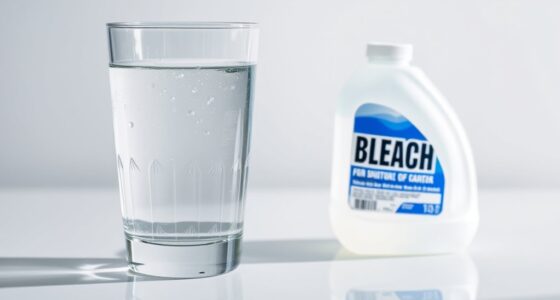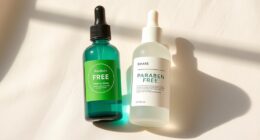The evidence shows that BPA leaches from receipts and plastic bottles, especially when handled frequently, heated, or scratched. This chemical mimics estrogen and can disrupt your hormones, leading to health risks like hormonal imbalances, developmental issues, and chronic diseases. Handling receipts transfers tiny amounts to your skin, while warming plastic bottles can increase BPA leaching into beverages. If you stay cautious, you’ll discover more ways to protect yourself from this pervasive chemical.
Key Takeaways
- BPA commonly transfers from receipts and plastic bottles through handling, especially when heated or scratched.
- Evidence links BPA exposure to hormonal disruption, developmental issues, and increased risk of chronic diseases.
- Repeated contact with BPA-laden receipts can lead to cumulative skin absorption and internal exposure.
- BPA can leach into beverages from plastic bottles, particularly when exposed to heat or sunlight.
- Reducing contact with receipts and choosing BPA-free plastics minimizes health risks associated with BPA exposure.

Many everyday items, like receipts and plastic bottles, contain BPA—a chemical linked to health risks. When you handle receipts or use certain plastics, BPA can transfer from these items to your skin or food, a process known as chemical migration. This migration occurs when BPA leaches out of the material, especially when exposed to heat, sunlight, or frequent handling. Once absorbed, BPA can enter your bloodstream, raising concerns about its potential health implications. Scientific studies suggest that even low-level exposure may disrupt hormonal balance, interfere with reproductive health, and increase the risk of certain cancers.
Handling receipts and plastics can transfer BPA, a chemical linked to hormonal and health risks.
The health implications of BPA exposure are a significant concern. Research indicates that BPA mimics estrogen, a vital hormone in your body, which can lead to hormonal imbalances. These imbalances might affect everything from your development during childhood to your fertility and metabolic health later in life. For example, pregnant women exposed to BPA could see effects on fetal development, potentially leading to behavioral or developmental issues in their children. Additionally, ongoing exposure has been linked to increased risks of obesity, diabetes, and cardiovascular diseases. The evidence points to a need for caution, especially considering that BPA can accumulate in your body over time.
Handling receipts regularly exposes you to BPA through chemical migration. When you touch receipts printed with BPA-based inks, tiny amounts can transfer onto your skin. Although the amount might seem small, repeated contact can lead to a cumulative effect, raising your overall exposure. Similarly, plastic bottles—particularly those made from polycarbonate—can release BPA into your beverages, especially if they’re heated or scratched. Consuming liquids from these bottles means you’re ingesting BPA, which then circulates in your body and may contribute to the health implications linked to this chemical. Understanding the projector technology involved can help you make more informed choices about the products you use daily.
Frequently Asked Questions
Are There Natural Alternatives to BPA Used in Manufacturing?
Yes, there are natural substitutes used in manufacturing as eco-friendly plastics. You can find options like plant-based plastics made from cornstarch or cellulose, which serve as safer alternatives to BPA. These eco-friendly plastics reduce environmental impact and health risks. Manufacturers increasingly adopt natural substitutes to promote sustainability and safety, making it easier for you to choose products that are better for your health and the planet.
How Long Does BPA Stay in the Human Body After Exposure?
BPA typically stays in your body for about 24 hours after exposure. Your body actively works on BPA elimination through processes like body detoxification, primarily via urine. To help speed up BPA elimination, stay well-hydrated and avoid further exposure. While your body naturally clears BPA quickly, reducing contact with BPA-containing products supports ongoing body detoxification and minimizes potential health risks.
Does BPA Exposure Affect Children Differently Than Adults?
Like a fragile glass needing careful handling, children are more vulnerable to BPA’s effects due to developmental sensitivity and physiological differences. Your child’s developing organs and systems make them more susceptible to hormonal disruptions caused by BPA exposure. Unlike adults, their bodies haven’t fully matured, so even small exposures can have larger impacts. Protect your little one by reducing BPA contact, understanding that their unique biology requires extra caution.
Are There Regulations Limiting BPA in Consumer Products Worldwide?
You’ll find that regulatory standards vary globally, with many countries setting limits on BPA in consumer products. Some nations have implemented international bans on BPA in items like baby bottles and food containers, reflecting growing concerns. However, not all regions have strict regulations, so it’s essential to stay informed about local policies. These regulations aim to reduce exposure, especially for vulnerable populations like children.
Can BPA Exposure Be Reversed or Mitigated Through Diet?
Yes, you can mitigate BPA exposure through diet by practicing a dietary detox and reducing your exposure sources. Focus on eating fresh, organic foods and avoiding canned products, plastic containers, and receipts. Drinking filtered water and using BPA-free products also help. While you can’t completely eliminate BPA, these steps support your body’s natural detox processes and lower overall exposure, promoting better health.
Conclusion
While the evidence on BPA’s health risks is still evolving, it’s wise to stay cautious. Limiting your exposure by choosing BPA-free products and washing receipts before handling them can make a difference. Remember, “A stitch in time saves nine,” so taking small steps now can prevent bigger health issues later. Stay informed, make mindful choices, and prioritize your well-being—you’re worth it.









